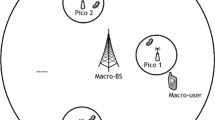Abstract
We propose a thoroughly optimal signal design strategy to achieve the Pareto boundary (boundary of the achievable rate region) with improper Gaussian signaling (IGS) on the Z-interference channel (Z-IC) under the assumption that the interference is treated as additive Gaussian noise. Specifically, we show that the Pareto boundary has two different schemes determined by the two paths manifesting the characteristic of improperly transmitted signals. In each scheme, we derive several concise closed-form expressions to calculate each user’s optimally transmitted power, covariance, and pseudo-covariance of improperly transmitted signals. The effectiveness of the proposed optimal signal design strategy is supported by simulations, and the results clearly show the superiority of IGS. The proposed optimal signal design strategy also provides a simple way to achieve the required rate region, with which we also derive a closed-form solution to quickly find the circularity coefficient that maximizes the sum rate. Finally, we provide an in-depth discussion of the structure of the Pareto boundary, characterized by the channel coefficient, the degree of impropriety measured by the covariance, and the pseudo-covariance of signals transmitted by two users.
Similar content being viewed by others
References
Agiwal, M., Roy, A., Saxena, N., 2016. Next generation 5G wireless networks: a comprehensive survey. IEEE Commun. Surv. Tutor., 18(3): 1617–1655. https://doi.org/10.1109/COMST.2016.2532458
Cadambe, V.R., Jafar, S.A., 2008. Interference alignment and degrees of freedom of the K-user interference channel. IEEE Trans. Inform. Theor., 54(8): 3425–3441. https://doi.org/10.1109/TIT.2008.926344
Cadambe, V.R., Jafar, S.A., Wang, C.W., 2010. Interference alignment with asymmetric complex signaling—settling the Høst-Madsen-Nosratinia conjecture. IEEE Trans. Inform. Theor., 56(9): 4552–4565. https://doi.org/10.1109/TIT.2010.2053895
Costa, M.H.M., 1985. On the Gaussian interference channel. IEEE Trans. Inform. Theor., 31(5): 607–615. https://doi.org/10.1109/TIT.1985.1057085
Hellings, C., Joham, M., Utschick, W., 2013. QoS feasibility in MIMO broadcast channels with widely linear transceivers. IEEE Signal Process. Lett., 20(11): 1134–1137. https://doi.org/10.1109/LSP.2013.2282186
Ho, Z.K.M., Jorswieck, E., 2012. Improper Gaussian signaling on the two-user SISO interference channel. IEEE Trans. Wirel. Commun., 11(9): 3194–3203. https://doi.org/10.1109/TWC.2012.071612.111338
Host-Madsen, A., Nosratinia, A., 2005. The multiplexing gain of wireless networks. Int. Symp. on Information Theory, p.2065–2069. https://doi.org/10.1109/ISIT.2005.1523709
Kim, C., Jeong, E.R., Sung, Y.C., et al., 2012. Asymmetric complex signaling for full-duplex decode-and-forward relay channels. Int. Conf. on Convergence, p.28–29. https://doi.org/10.1109/ICTC.2012.6386770
Kurniawan, E., Sun, S.M., 2015. Improper Gaussian signaling scheme for the Z-interference channel. IEEE Trans. Wirel. Commun., 14(7): 3912–3923. https://doi.org/10.1109/TWC.2015.2414913
Lagen, S., Agustin, A., Vidal, J., 2016. Coexisting linear and widely linear transceivers in the MIMO interference channel. IEEE Trans. Signal Process., 64(3): 652–664. https://doi.org/10.1109/TSP.2015.2489604
Lameiro, C., Santamaria, I., Schreier, P.J., 2017. Rate region boundary of the SISO Z-interference channel with improper signaling. IEEE Trans. Commun., 65(3): 1022–1034. https://doi.org/10.1109/TCOMM.2016.2641948
Motahari, A.S., Khandani, A.K., 2009. Capacity bounds for the Gaussian interference channel. IEEE Trans. Inform. Theor., 55(2): 620–643. https://doi.org/10.1109/TIT.2008.2009807
Neeser, F.D., Massey, J.L., 1993. Proper complex random processes with applications to information theory. IEEE Trans. Inform. Theor., 39(4): 1293–1302. https://doi.org/10.1109/18.243446
Sato, H., 1981. The capacity of the Gaussian interference channel under strong interference. IEEE Trans. Inform. Theor., 27(6): 786–788. https://doi.org/10.1109/TIT.1981.1056416
Telatar, E., 1999. Capacity of multi-antenna Gaussian channels. Eur. Trans. Telecommun., 10(6): 585–595. https://doi.org/10.1002/ett.4460100604
Zeng, Y., Yetis, C.M., Gunawan, E., et al., 2013a. Transmit optimization with improper Gaussian signaling for interference channels. IEEE Trans. Signal Process., 61(11): 2899–2913. https://doi.org/10.1109/TSP.2013.2254480
Zeng, Y., Zhang, R., Gunawan, E., et al., 2013b. Optimized transmission with improper Gaussian signaling in the K-user MISO interference channel. IEEE Trans. Wirel. Commun., 12(12): 6303–6313. https://doi.org/10.1109/TWC.2013.103013.130439
Author information
Authors and Affiliations
Corresponding author
Additional information
Project supported by the National Natural Science Foundation of China (Nos. 61601477 and 61601482)
Rights and permissions
About this article
Cite this article
Li, D., Wang, S. & Gu, Fl. Optimal signal design strategy with improper Gaussian signaling in the Z-interference channel. Frontiers Inf Technol Electronic Eng 18, 1900–1912 (2017). https://doi.org/10.1631/FITEE.1700030
Received:
Accepted:
Published:
Issue Date:
DOI: https://doi.org/10.1631/FITEE.1700030




